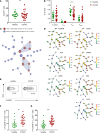Fgl2 regulates FcγRIIB+CD8+ T cell responses during infection
- PMID: 40197366
- PMCID: PMC11981615
- DOI: 10.1172/jci.insight.186259
Fgl2 regulates FcγRIIB+CD8+ T cell responses during infection
Abstract
While the inhibitory receptor FcγRIIB has been shown to be upregulated on activated CD8+ T cells in both mice and humans, its effect on T cell fate during infection has not been fully elucidated. We identified an increase in FcγRIIB-expressing CD8+ T cells in patients with COVID-19 relative to healthy controls as well as in mouse models of viral infection. Despite its well-known role as an Fc receptor, FcγRIIB also ligates the immunosuppressive cytokine Fgl2, resulting in CD8+ T cell apoptosis. Both chronic LCMV infection in mice and COVID-19 in humans resulted in a significant increase in plasma Fgl2. Transfer of CD8+ T cells into a Fgl2-replete, but not Fgl2-devoid, environment resulted in elimination of FcγRIIB+, but not FcγRIIB-, CD8+ T cells. Similarly, plasma Fgl2 was directly proportional to CD8+ T cell lymphopenia in patients with COVID-19. RNA-Seq analysis demonstrated that Fgl2 was produced by murine virus-specific CD8+ T cells, with an increase in Fgl2 in CD8+ T cells elicited during chronic versus acute viral infection. Fgl2 was also upregulated in CD8+ T cells from patients with COVID-19 versus healthy controls. In summary, CD8+ T cell production of Fgl2 during viral infection underpinned an FcγRIIB-mediated loss of CD8+ T cell immunity in both mice and humans.
Keywords: Adaptive immunity; Immunology; T cells.
Figures





References
MeSH terms
Substances
Grants and funding
LinkOut - more resources
Full Text Sources
Medical
Research Materials
Miscellaneous

